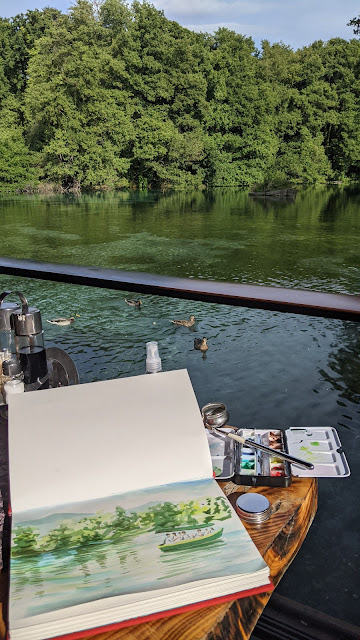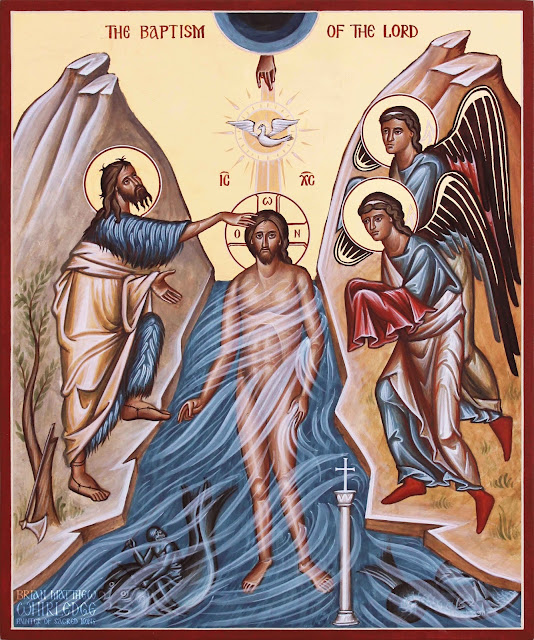Herakleia, Kurbinovo, and Lake Ohrid
Saint George Church, Kurbinovo was the highlight today.
Herakleia Lynkestis
Herakleia Lynkestis was an ancient Greek city in Macedon, and it later became a Roman city. As the city became Christians, several basilicas and a baptistery were built. Herkleia is known for its mosaics.
The basilicas were built between 490-530 during the reign of the Monophysite emperor Anastasios. The Monophysite heresy (meaning "one nature") denied the human nature of Christ, saying that his divine nature consumed his human nature, something like sugar dissolves into water. As such, Monophysites favored allegory rather than narrative, since Christ's divinity cannot be depicted.
In this mosaic, the deer represent Christians, from Psalm 41/42 "As the deer longs for fountains of water, so my soul longs for you, O God." The chalice represents Christ, especially in Holy Communion, in the liturgical context of the mural. It also reminds us "I am the vine; you are the branches. Whoever abides in me, and I in him, bears much fruit." (St. John 15:5). The peacocks represent eternal life, since ancient Greeks believed that peacock flesh does not decay (at least their feathers don't).
A leopard killing a deer is an allegorical depiction of martyrdom.
Murals of this detail are rare for floors. It is possible these mosaics were originally on a wall, then moved to the floor after an earthquake damaged the walls. The enlongated figures support this theory, as the foreshortened view from the floor to a high wall would correct the optical distortion.
St. George Church at Kurbinovo
St. George Church was today's pearl, a true jewel. I've referenced these frescoes in my work for years. It was so awesome to see these one-of-a-kind frescoes in person and up close.
Here is the Archangel Gabriel from Kurbinovo which partially inspired my own icon of the Ascension.
I was delighted to spend a few intimate minutes with the magnificent Archangel Gabriel today.
The church is undergoing significant renovations and conservation. As such, it is entirely closed to the public and to tourists. However, Father Ilya has incredible connections and was able to gain access to the church. Scaffolding filled the church, obscuring the iconography. There was no electric light, and the scaffolding shaded what little natural light came in through the doors and small windows. However, the scaffolding afforded us a once-in-a-lifetime opportunity to see the upper frescoes up close.
I wasn't able to sketch as much as I would have liked, since the scaffolding was very narrow and precarious, and I had to share the small, dark space with others. At the moment, wifi is uploading my photos very slowly, so I can't share my sketches or my own photos. Many of my own photos will be useful for reference, but are partially obscured by scaffolding, so the photos of the frescoes I'm sharing here are not my own.
A few of the quick sketches I was able to make today on the scaffolding.
These Komnenian frescoes from 1191 show a unique mannerist energy in the undulating flow of the garments. The billows show almost a wind, like on the day of Pentecost. The figures show dynamic movement and dramatic motion. The colors are rich and bold. The modeling on the flesh is exquisite.
90% of all Balkan churches were destroyed during the Ottoman period, especially large, important churches in cities. The reason this treasure survived is because of its remote location in a small village high in a mountain and its small size. If small provincial village churches were adorned like this, imagine the glory that once existed and has been lost.
In the remote village of Kurbinovo below the church, some villagers were distilling rakia as we transferred to and from smaller vans that could take us up to the church. During the transfer, the ever-friendly Sergei, who always wears a big smile, procured a sample in an empty water bottle, which he shared around. It was very smooth, delicious, and warm. I just had to participate in an authentic Macedonian experience!
Ohrid
I made a quick painting while waiting for my food to arrive.
Saint Naum of Ohrid flourished in the ninth century when he founded this monastery. He and Saint Clement of Ohrid were a disciples of Saints Cyril and Methodius, who begun to evangelize the Slavic peoples and developed an alphabet and written language. Saint Naum translated the entire Bible and church services into Slavonic. His work was essential for the Christianization of all Slavic peoples, especially the Rus to the north, who would convert en masse within 7 decades of his repose. His miraculous relics rest in this monastery to this day.
Saint Nicholai Velomirovich restored and revived monastic life here in the early 20th century. It was at Ohrid that he wrote "Prayers by the Lake." The Nazis captured him here and took him to Dachau, and later he came to America.
Peacocks roam the monastery grounds as a constant reminder of eternal life.
I couldn't resist a paddle up into the springs. I didn't even have to exert any effort since I hired a boat with a oarsman to paddle for me! Look at the clarity of that water!
I finished completely filling my first sketchbook today at Herakleia, and begun the new sketchbook at Kurbinovo. I hope to make significant progress in my new sketchbook tomorrow in Ohrid.






























.jpeg)

Comments
Post a Comment